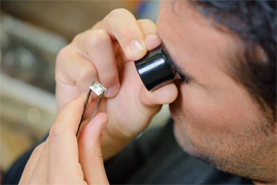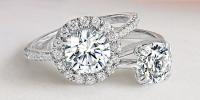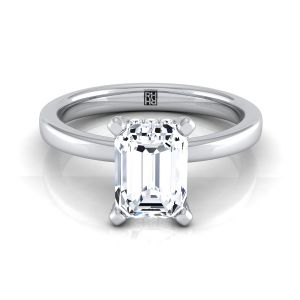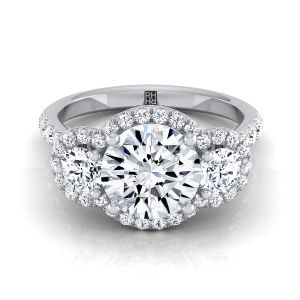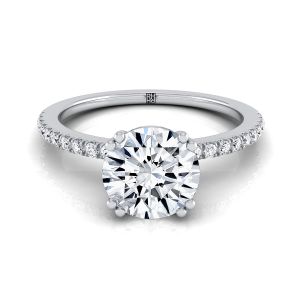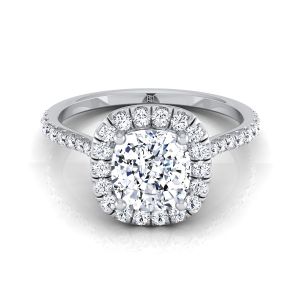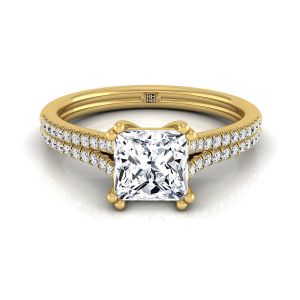Lab Created Diamonds vs. Natural Diamonds
What do you love most about diamonds? Do you love the stories of their rich history, from crystallizing deep in the earth a billion years ago to kings and queens and crown jewels to the traditional forever on millions of bended knees? Or do you love what they are: pure crystals of carbon with breathtaking brilliance, dispersion and scintillation?
This is the choice offered by natural diamonds vs lab created diamonds. Natural diamonds are a rare and valuable gift from the earth, valued throughout history. Lab grown diamonds are a technological marvel, a result of scientists finally solving the riddle of creating gem-quality diamonds in the laboratory.
Although lab-grown diamonds are a relatively new option for engagement ring and jewelry shoppers, more and more of our customers are considering lab grown vs natural diamonds when shopping for an engagement ring. A recent survey by The Knot found that 25% of couples chose a lab-grown engagement ring in 2021.
Because natural diamonds and lab grown diamonds are virtually the same on the atomic level, the main difference between the two is how and where they form.
If you are considering lab created diamonds vs natural diamonds for your engagement ring, here are all the facts about similarities and differences and advantages and disadvantages of each kind of diamond so you can make an informed decision about what’s best for you.
How Natural Diamonds Form
All the diamonds we can discover on earth formed a billion or so years ago deep inside the crust. Diamonds near the surface of the earth were carried there by long-ago super volcanoes that were part of the continent-forming process. Crystallized under intense heat and pressure, they are the oldest thing you can own.
Natural diamonds are a non-renewable resource. For every diamond that you take out of the ground, there’s one less to find. Mining diamonds is often a huge undertaking, requiring moving mountains of earth in remote areas of the planet like the arctic, the savannah, or the outback. In fact, 250 tons of earth have to be mined to uncover a single carat of natural diamond. Mining companies also have to build all the infrastructure like roads, power lines, and housing for workers. All of that is expensive, adding to the cost of natural diamonds.
Many diamond mines, including Argyle in Australia, once the world’s largest diamond mine, have closed because all the easily mined diamonds have been recovered. Although there may be new mines to find in the arctic or in Africa, natural diamond production peaked in 2005. Natural diamonds will undoubtedly be more rare in the future.
How Lab Created Diamonds Form
Scientists have been trying to grow diamond crystals in the laboratory for centuries but they didn’t succeed until 1956, when General Electric researchers created tiny diamond crystals in a huge press under high pressure and high temperature. For decades, lab grown diamonds were used for abrasives and industrial purposes because they weren’t large enough or pure enough to be cut as gemstones.
The process improved gradually, producing larger and larger diamonds. Gem-quality lab created diamonds have only been readily available for the past decade.
Today lab created diamonds are produced by two processes: HPHT and CVD. HPHT or High Pressure High Temperature diamonds are produced by placing a diamond seed in a diamond press with a carbon source and subjecting it to high pressure and high temperature similar to the conditions deep in the earth where diamonds form naturally. Gradually the crystal grows on the seed in a unique cuboctahedral shape.
CVD or Chemical Vapor Deposition diamonds are grown in a very different way. A diamond seed is placed in a vacuum chamber which is filled with methane and hydrogen gas. The gas is heated to form a plasma, which releases the carbon atoms from the plasma to bond with the seed, growing diamond atom by atom and layer by layer. The diamond grows in the cubic system in a solid block on the seed.
Lab Created Diamonds vs Natural Diamonds: Similarities
Both natural diamonds and lab created diamonds have the same physical, chemical and optical properties. That means they also have the same brilliance, refraction, reflection, scintillation, hardness, and thermal conductivity.
Both lab grown diamonds and natural diamonds are cut in polished in the same way, using the same equipment. Cutters choose the same shapes and the same proportions to make them look their best. In fact, once they are cut they look identical, even to a gemologist.
They are graded using the same 4Cs of diamond quality by the same independent grading laboratories, the Gemological Institute of America, the International Gemological Institute, and other labs around the world.
Lab Created Diamonds vs Natural Diamonds: Differences
The main difference between lab grown diamonds vs natural diamonds is where and how they form. The way natural diamonds and lab created diamonds grow leaves clues in the crystals: growth patterns that can be detected with advanced gemological testing. Lab-created diamonds are Type IIa, the purest type of diamond. Less than 2% of natural diamonds are Type IIa. Jewelers can use machines to test whether diamonds are Type IIa: if the diamond is not, it must be natural. If it is, it can be referred to a lab for further testing.
Because scientists are getting better and better at growing lab created diamonds, they may become more available and affordable in the future. Natural diamonds are expected to become rarer as existing mines are depleted and fewer new mines are discovered. So natural diamonds may increase in value and lab grown diamonds may decrease in value in the future.
The most important question about lab created diamonds vs natural diamonds is which is right for you. If you are looking for the most big beautiful diamond you can afford today, choosing a lab grown diamond helps you double your carats and improve your quality for the same price. If you are investing for tomorrow, natural diamonds are likely to be more rare and valuable in the future.










